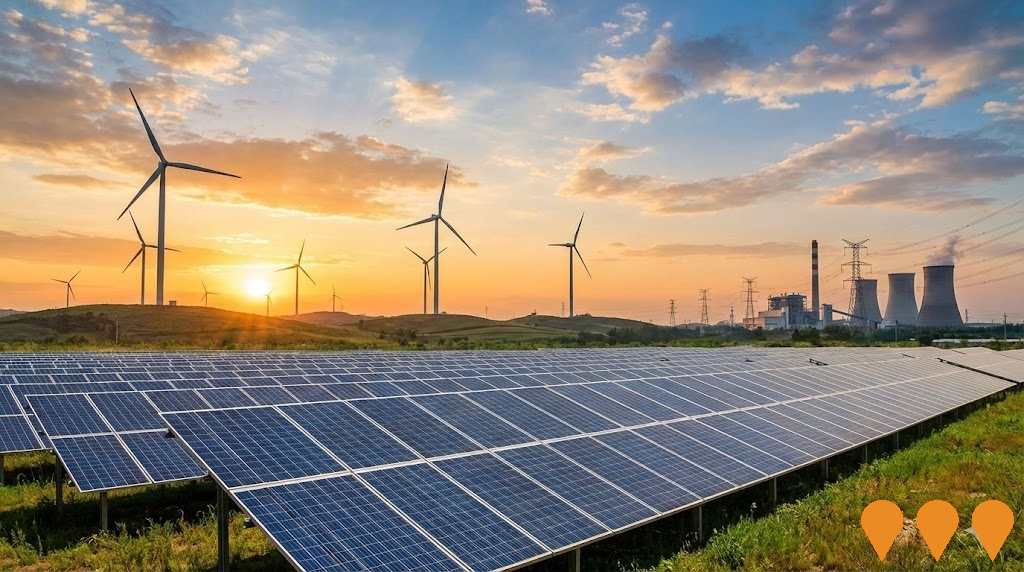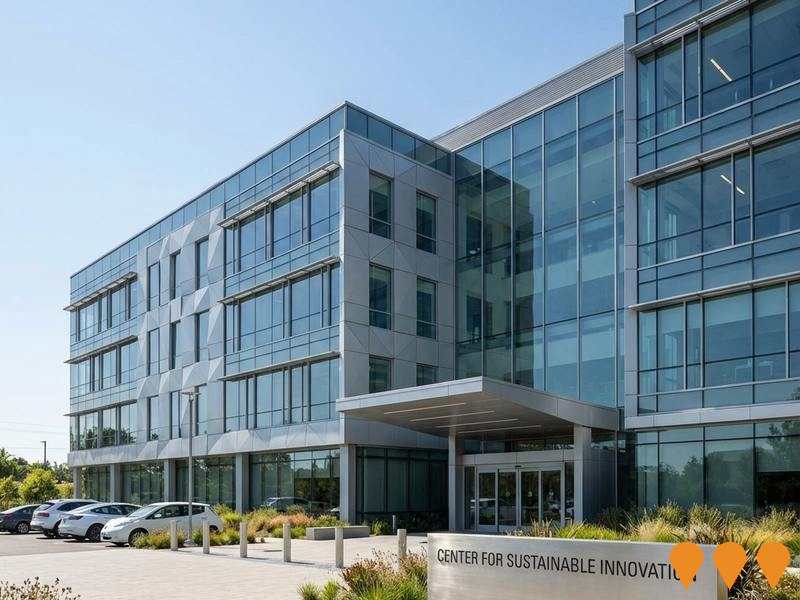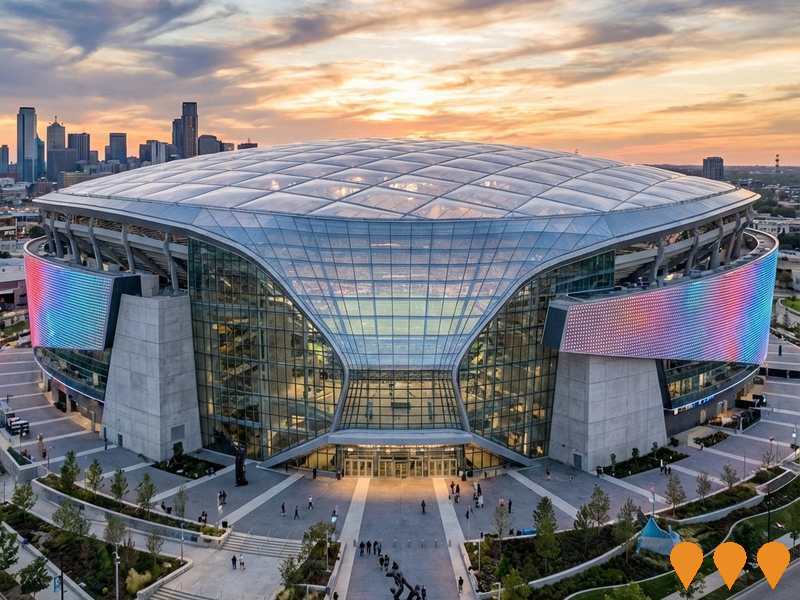Chart Color Schemes
est. as @ -- *
ABS ERP | -- people | --
2021 Census | -- people
Sales Activity
Curious about local property values? Filter the chart to assess the volume and appreciation (including resales) trends and regional comparisons, or scroll to the map below view this information at an individual property level.
Find a Recent Sale
Sales Detail
Population
South Mackay is positioned among the lower quartile of areas assessed nationally for population growth based on AreaSearch's assessment of recent, and medium term trends
South Mackay's population was around 7,192 as of Aug 2025. This figure, an increase from the 6,918 reported in the 2021 Census, reflects a growth of 274 people (4.0%) since then. The change is inferred from ABS's estimated resident population of 7,190 as of June 2024 and two validated new addresses since the Census date. This results in a population density ratio of 1,043 persons per square kilometer, comparable to averages seen across locations assessed by AreaSearch. South Mackay's 4.0% growth since census is within 2.6 percentage points of the SA3 area (6.6%), indicating competitive growth fundamentals. Natural growth contributed approximately 52.2% of overall population gains during recent periods.
AreaSearch uses ABS/Geoscience Australia projections for each SA2 area, released in 2024 with a base year of 2022. For areas not covered by this data and years post-2032, Queensland State Government's SA2 area projections are adopted, released in 2023 based on 2021 data. However, these state projections lack age category splits, so AreaSearch applies proportional growth weightings aligned with ABS Greater Capital Region projections for each age cohort, released in 2023 using 2022 data. Demographic trends indicate a decline in overall population over the period, with South Mackay's population expected to shrink by 380 persons by 2041. However, specific age cohorts are projected to grow, notably the 25 to 34 age group, anticipated to increase by 233 people.
Frequently Asked Questions - Population
Development
Residential development activity is lower than average in South Mackay according to AreaSearch's national comparison of local real estate markets
South Mackay experienced limited development activity between 2016 and 2020, with an average of two approvals per year for dwellings. This resulted in a total of ten dwellings over the five-year period. Such low development levels are characteristic of rural areas where housing needs are modest and construction activity is limited by local demand and infrastructure capacity.
It should be noted that due to the small number of approvals, individual projects can significantly impact annual growth and relativity statistics. South Mackay showed less construction activity compared to the rest of Queensland during this period. The development pattern in South Mackay was also below national averages. All new constructions between 2016 and 2020 were detached houses, reflecting the area's rural character where larger properties and space are typical.
Notably, developers constructed more detached housing than the existing pattern implied at Census (73.0%), indicating persistent strong demand for family homes despite densification trends. Given stable or declining population forecasts, South Mackay may experience less housing pressure in the future, creating favourable conditions for buyers.
Frequently Asked Questions - Development
Infrastructure
South Mackay has moderate levels of nearby infrastructure activity, ranking in the 44thth percentile nationally
Local infrastructure changes significantly influence an area's performance. AreaSearch identified eight projects likely impacting the region. Notable projects are Mackay Airport Expansion, Milton Precinct, Mackay Base Hospital Expansion, and Great Barrier Reef Arena Redevelopment, with the following list providing details on the most relevant ones.
Professional plan users can use the search below to filter and access additional projects.
INFRASTRUCTURE SEARCH
 Denotes AI-based impression for illustrative purposes only, not to be taken as definitive under any circumstances. Please follow links and conduct other investigations from the project's source for actual imagery. Developers and project owners wishing us to use original imagery please Contact Us and we will do so.
Denotes AI-based impression for illustrative purposes only, not to be taken as definitive under any circumstances. Please follow links and conduct other investigations from the project's source for actual imagery. Developers and project owners wishing us to use original imagery please Contact Us and we will do so.
Frequently Asked Questions - Infrastructure
Mackay Base Hospital Expansion
Major expansion of Mackay Base Hospital to deliver 128 additional inpatient beds, new birthing suites, maternity ward, special care nursery, child and adolescent unit, medical wards, a new multi-storey car park with rooftop helipad, and a new clinical services building. BESIX Watpac is the managing contractor. Construction is underway on early works and the car park; main hospital wing construction progressing. Latest Queensland Health updates confirm revised completion target of 2028 with total project cost approximately $520 million.
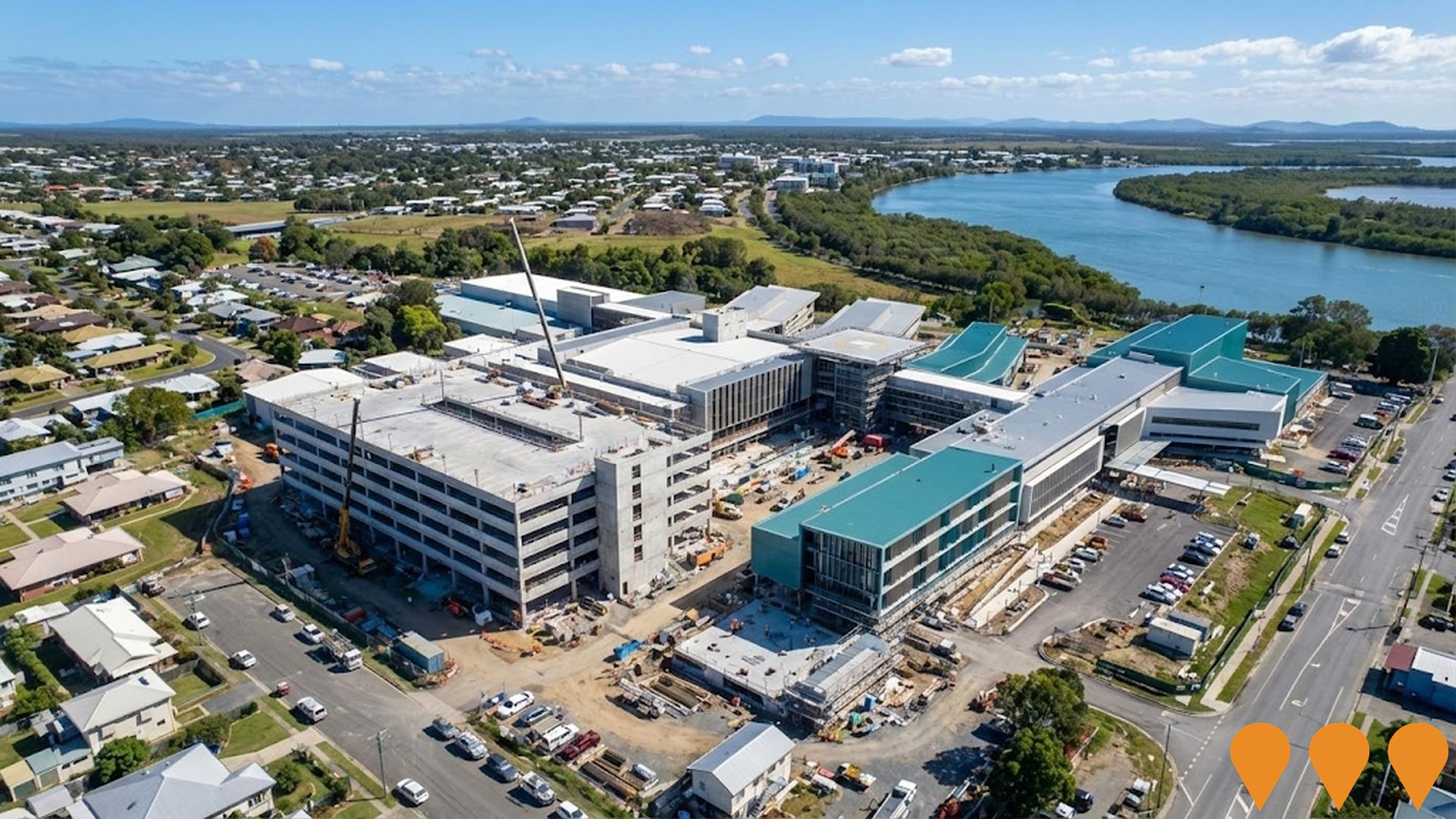
Milton Precinct
A new long-term, staged business, retail, and mixed-use service hub strategically located on Mackay Airport land holdings adjacent to the Bruce Highway and Peak Downs Highway. Stage 1 (completed 2025, $9.7 million) includes civil works opening 25,000 sqm of serviced lots for retail and commercial activities. The precinct is estimated to provide $134.1 million to the local economy in its first 10 years, with businesses generating $42.5 million in output per year and supporting approximately 280 onsite jobs. Further development scheduled through 2026-2028.
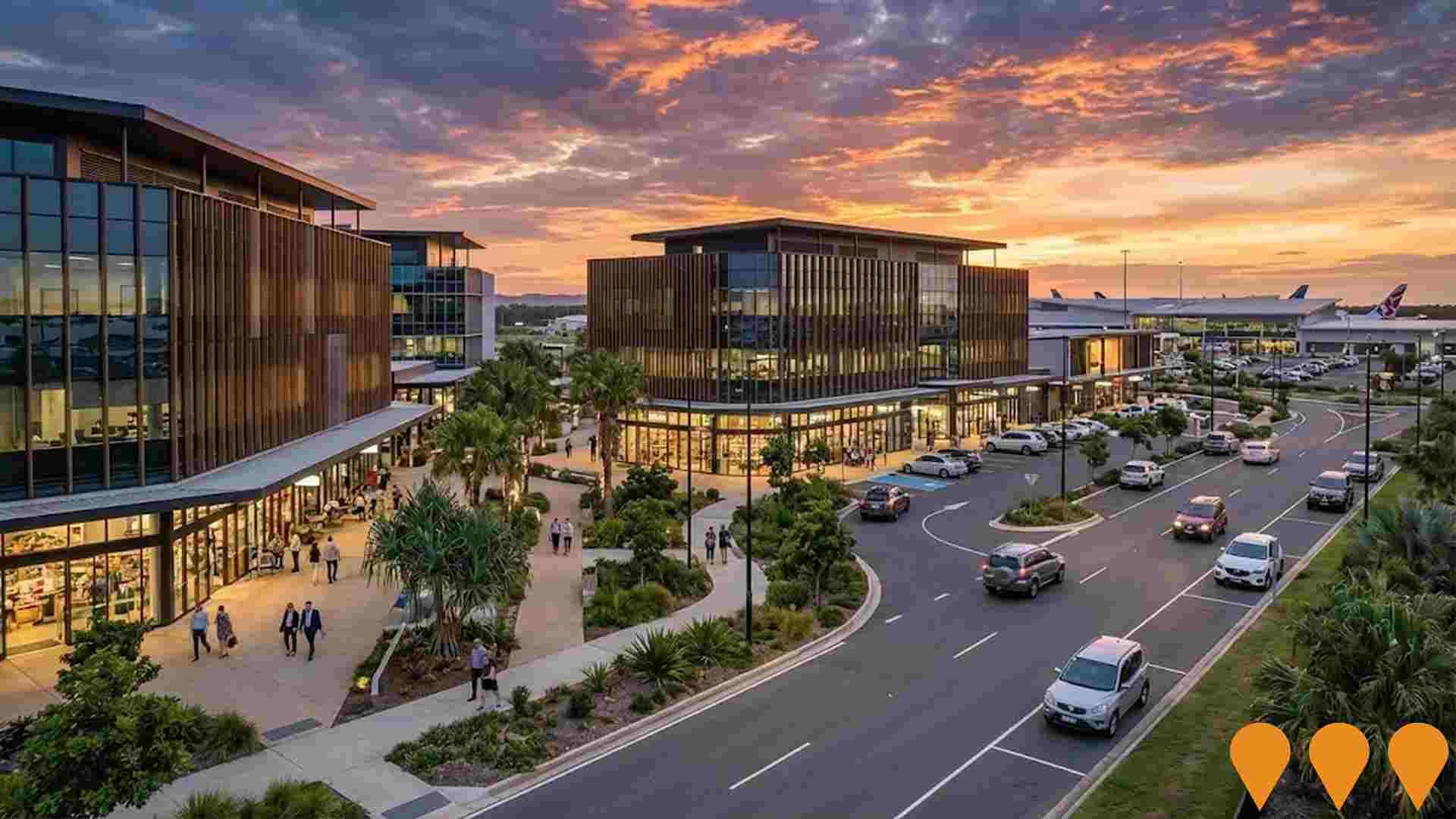
Ooralea Local Plan
A strategic local plan prepared by Mackay Regional Council to guide urban development in the Ooralea area. Key features include a proposed mixed-use Major Centre, Specialised Centre (Homemaker Centre), interconnected walkable neighborhoods, open spaces, integration with surrounding infrastructure like Central Queensland University, and a simple, functional road network. The plan informed the Mackay Region Planning Scheme 2017.
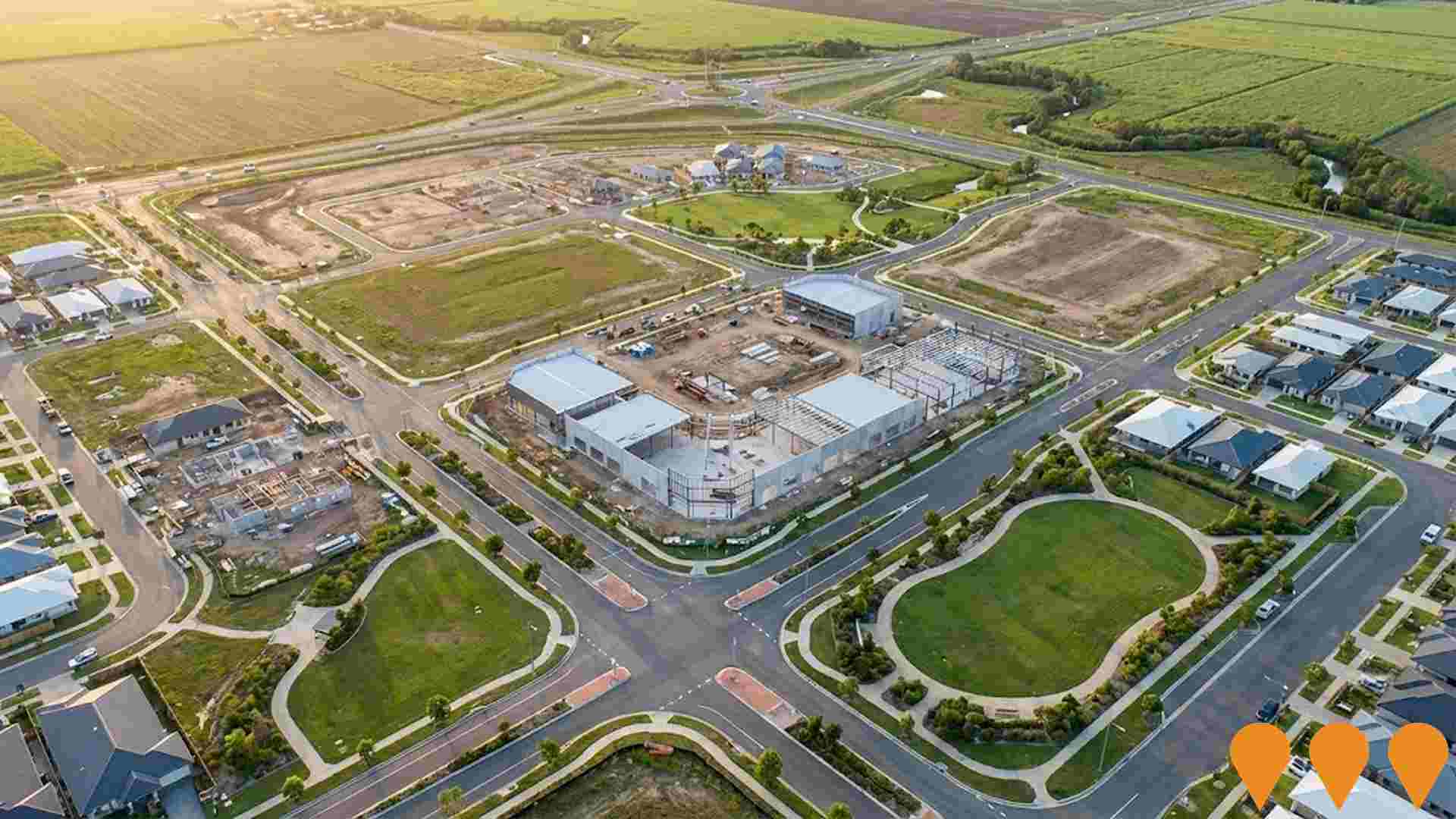
Northern Beaches Community Hub
The Northern Beaches Community Hub is a multi-stage community facility in Mackay's fastest-growing northern suburbs. Stage 1A, opened in July 2025, features an undercover multi-purpose court for basketball, netball, futsal, and pickleball, a 29m crocodile-shaped amphitheatre, nature play area with climbing nets, swings, slide, balance beam, picnic spaces, landscaping, and parking. Stage 1B, under construction since July 2025 and expected to complete by December 2026, includes a modern library, flexible community rooms, town square for events, cafe space, undercover car park, and a Changing Places facility. The hub serves a population projected to grow to over 32,000 by 2041, providing a welcoming meeting place for community activities, programs, and services.
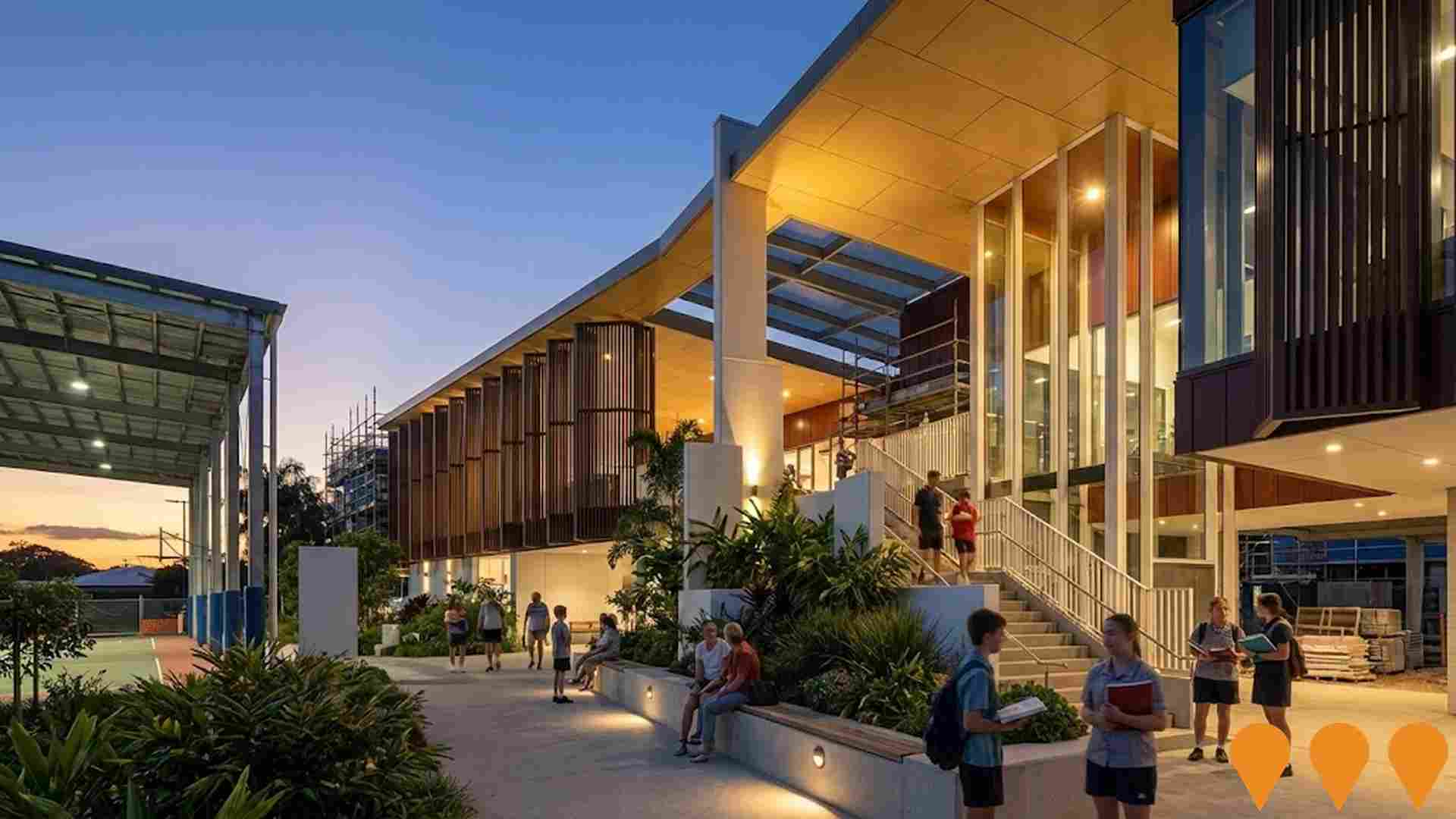
Mackay Airport Expansion
Terminal expansion and runway improvements to accommodate larger aircraft and increased passenger capacity. New cargo facilities and parking infrastructure included.
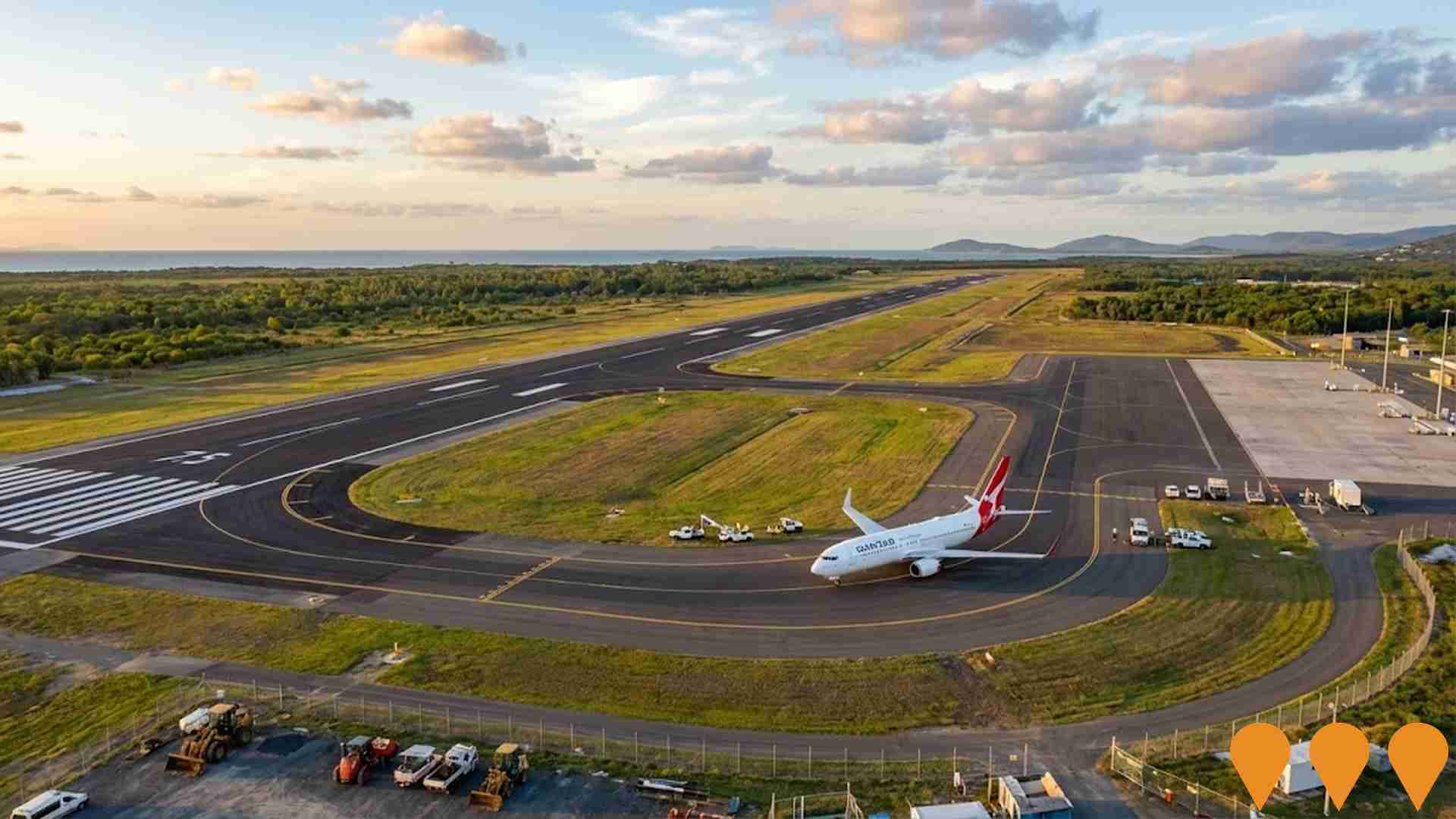
Mackay State Development Area
907 hectares designated for renewable energy and biofutures industries. Supports regional economic diversification and sustainable aviation fuel production. Leverages Mackay's agricultural strengths for net-zero transition industries. Declared February 2024 with development scheme approved September 2024. The SDA incorporates two distinct areas: Racecourse Mill area (137 hectares) approximately 5km west of Mackay CBD, and Rosella area (770 hectares) located 10km south of Mackay CBD. Designed to become Queensland's home for emerging biocommodity industry.
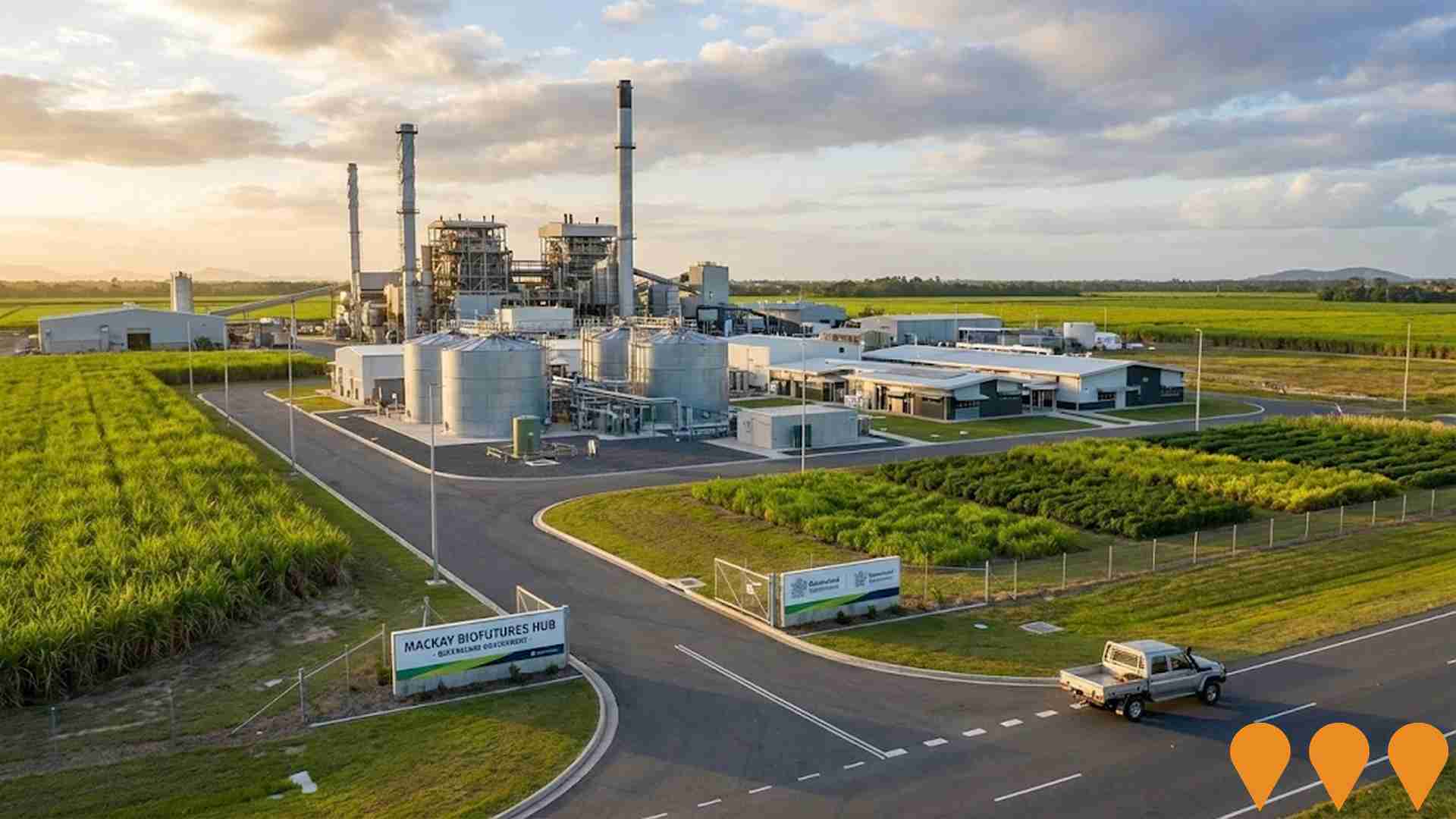
Mackay Port Access Bruce Highway to Mackay Slade Point Road Stage 1
A new 9.5km, 2-lane access road from the Bruce Highway at Glenella to Mackay-Slade Point Road (Harbour Road), to improve access to the Port of Mackay while addressing urban congestion in North Mackay.
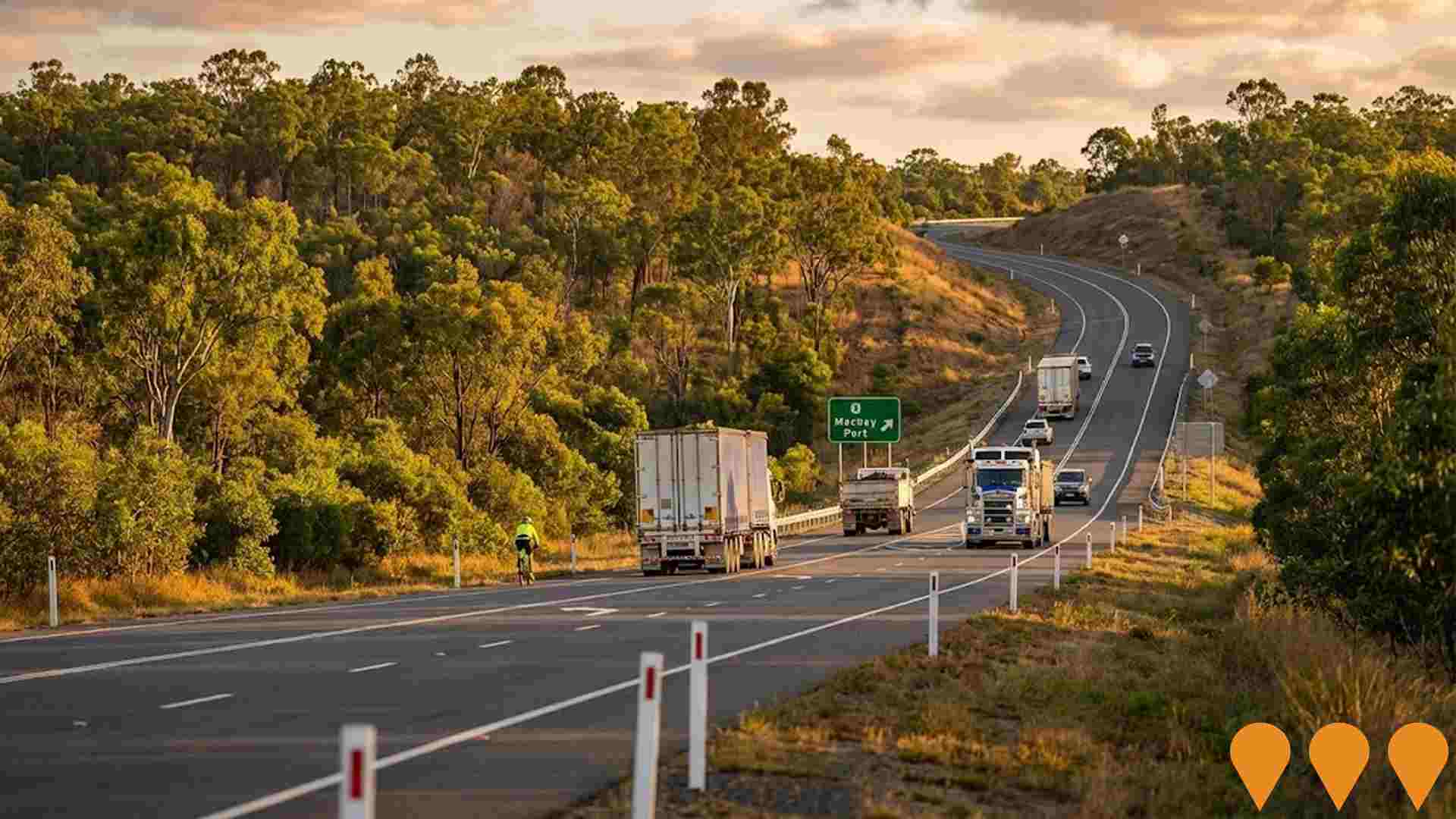
South Mackay Industrial Estate
Situated in the heart of Mackay's burgeoning bioenergy hub, the South Mackay Industrial Estate offers flat, serviced industrial land with excellent transport links to the Bruce Highway, Mackay Harbour, and the airport. It positions businesses to leverage the region's agricultural industry, R&D expertise, the planned Future Foods Biohub, and bioenergy policies. The estate comprises 11 industrial allotments over 12 hectares, with the final lots available for sale as of 2025.
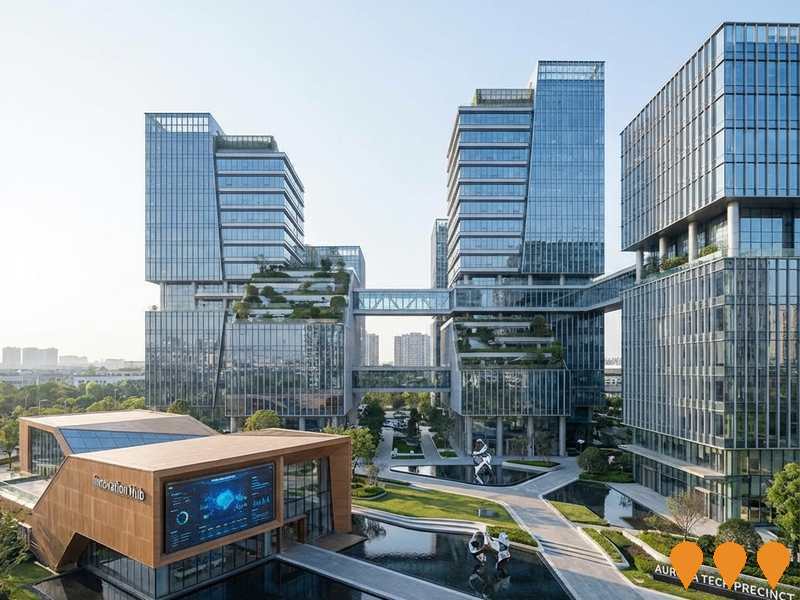
Employment
AreaSearch analysis places South Mackay well above average for employment performance across multiple indicators
South Mackay has a diverse workforce with both white and blue collar jobs, particularly in manufacturing and industrial sectors. The unemployment rate was 2.8% as of June 2025, with an estimated employment growth of 1.3% over the past year.
In South Mackay, 3765 residents were employed, with an unemployment rate of 1.2%, lower than Rest of Qld's rate of 3.9%. Workforce participation was at 62.2%, close to Rest of Qld's 59.1%. Key employment sectors included health care & social assistance, retail trade, and construction. Notably, mining employed 2.3 times the regional average, while agriculture, forestry & fishing employed just 0.8% of local workers, lower than Rest of Qld's 4.5%.
Over a 12-month period ending June 2025, employment increased by 1.3%, labour force decreased by 0.4%, leading to a fall in unemployment rate by 1.6 percentage points. In contrast, Rest of Qld saw employment rise by 1.8% and unemployment rise by 0.2%. Jobs and Skills Australia's national employment forecasts from May 2025 project a 6.6% growth over five years and 13.7% over ten years nationally. Applying these projections to South Mackay's employment mix suggests local growth of approximately 5.9% over five years and 12.8% over ten years, though this is a simple extrapolation for illustrative purposes only.
Frequently Asked Questions - Employment
Income
Income levels align closely with national averages, indicating typical economic conditions for Australian communities according to AreaSearch analysis
AreaSearch's data for financial year 2022 shows South Mackay's median income was $54,878 and average income was $68,618. This is higher than Rest of Qld's median income of $50,780 and average income of $64,844. As of September 2025, estimated incomes are approximately $62,555 (median) and $78,218 (average), based on a 13.99% Wage Price Index growth since financial year 2022. Census 2021 data ranks South Mackay's household, family, and personal incomes modestly, between the 34th and 47th percentiles. The $1,500 - $2,999 income bracket dominates with 34.1% of residents (2,452 people), consistent with regional trends at 31.7%. Housing affordability pressures are severe in South Mackay, with only 84.6% of income remaining, ranking at the 36th percentile.
Frequently Asked Questions - Income
Housing
South Mackay is characterized by a predominantly suburban housing profile, with a higher proportion of rental properties than the broader region
South Mackay's dwelling structures, as per the latest Census, were 73.4% houses and 26.6% other dwellings (semi-detached, apartments, 'other' dwellings). This compares to Non-Metro Qld's figures of 85.1% houses and 14.9% other dwellings. Home ownership in South Mackay was at 27.7%, with the remaining dwellings either mortgaged (32.9%) or rented (39.3%). The median monthly mortgage repayment was $1,500, below Non-Metro Qld's average of $1,733 and the national average of $1,863. The median weekly rent in South Mackay was $290, compared to Non-Metro Qld's $340 and the national figure of $375.
Frequently Asked Questions - Housing
Household Composition
South Mackay features high concentrations of lone person households, with a lower-than-average median household size
Family households constitute 62.7% of all households, including 23.1% couples with children, 24.6% couples without children, and 13.4% single parent families. Non-family households comprise the remaining 37.3%, with lone person households at 34.0% and group households comprising 3.4%. The median household size is 2.3 people, smaller than the Rest of Qld average of 2.6.
Frequently Asked Questions - Households
Local Schools & Education
Educational outcomes in South Mackay fall within the lower quartile nationally, indicating opportunities for improvement in qualification attainment
The area has lower university qualification rates at 13.8% compared to the Australian average of 30.4%. This presents both a challenge and an opportunity for targeted educational initiatives. Bachelor degrees are most common at 10.7%, followed by postgraduate qualifications (1.6%) and graduate diplomas (1.5%). Vocational credentials are prominent, with 42.3% of residents aged 15+ holding such qualifications - advanced diplomas at 7.7% and certificates at 34.6%.
Educational participation is high, with 27.9% of residents currently enrolled in formal education. This includes 10.6% in primary, 8.1% in secondary, and 3.5% pursuing tertiary education. South Mackay's 3 schools have a combined enrollment of 1,574 students and demonstrate typical Australian school conditions (ICSEA: 992) with balanced educational opportunities. Educational provision is conventional, split between 1 primary and 2 secondary institutions. School capacity exceeds typical residential needs (21.9 places per 100 residents vs 17.1 regionally), indicating the area serves as an educational center for the broader region. Note: where schools show 'n/a' for enrolments please refer to parent campus.
Frequently Asked Questions - Education
Schools Detail
Nearby Services & Amenities
Transport
Transport servicing is low compared to other areas nationally based on assessment of service frequency, route connectivity and accessibility
Transport analysis shows 26 active stops operating in South Mackay, serving a mix of bus routes. These are serviced by 4 individual routes, offering 222 weekly passenger trips collectively. Transport accessibility is rated good, with residents typically located 239 meters from the nearest stop.
Service frequency averages 31 trips per day across all routes, equating to approximately 8 weekly trips per stop.
Frequently Asked Questions - Transport
Transport Stops Detail
Health
Health performance in South Mackay is lower than average with common health conditions somewhat prevalent across both younger and older age cohorts
South Mackay faces significant health challenges, with common health conditions prevalent across both younger and older age cohorts. Approximately 54% (~3862 people) have private health cover, compared to 57.0% across the rest of Queensland.
The most common medical conditions are arthritis (affecting 8.5% of residents) and mental health issues (also affecting 8.5%). Around 66.6% declare themselves completely clear of medical ailments, compared to 69.7% in the rest of Queensland. In South Mackay, 18.7% (~1343 people) are aged 65 and over, higher than the 16.2% in the rest of Queensland. Health outcomes among seniors present some challenges, broadly in line with the general population's health profile.
Frequently Asked Questions - Health
Cultural Diversity
South Mackay ranks below the Australian average when compared to other local markets across a number of language and cultural background related metrics
South Mackay, as per the data, has a cultural diversity index below average. Its population is predominantly Australian citizens, with 85.0% holding citizenship and 83.9% being born in Australia. English is the primary language spoken at home by 90.0% of residents.
Christianity is the dominant religion in South Mackay, accounting for 59.9% of the population, compared to 56.8% across the rest of Queensland. The top three ancestry groups are Australian (27.5%), English (27.3%), and Irish (8.4%). Some ethnic groups show significant variation: Filipino residents make up 4.3%, higher than the regional average of 1.5%; Maltese residents comprise 1.4% compared to the region's 2.4%; New Zealanders constitute 0.9%, slightly above the regional average of 0.7%.
Frequently Asked Questions - Diversity
Age
South Mackay's population is slightly older than the national pattern
The median age in South Mackay is 39 years, which is lower than the Rest of Qld's average of 41 but close to the national average of 38. The age profile shows that those aged 25-34 are prominent at 15.8%, while the 45-54 group is smaller at 10.7% compared to Rest of Qld. Between 2021 and present, the 25-34 age group has grown from 13.7% to 15.8%. Conversely, the 45-54 cohort has declined from 12.4% to 10.7%. By 2041, demographic projections show significant shifts in South Mackay's age structure. The 25-34 age cohort is projected to increase by 166 people (15%) from 1,137 to 1,304. Conversely, both the 65-74 and 35-44 age groups are projected to decrease in numbers.
